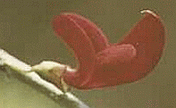Nestled below the verdant Morne Bruce hill, and located about 50 meters from the Roseau River, is the 40-acre Botanic Gardens of Dominica. This area of undulating land is the largest tract of semi-open space in the city of Roseau. With an elevation of about 66 ft (20 meters) above sea level, the Botanic Gardens receives approximately 85 inches (218 cm) of rainfall annually, with favorable conditions for the growing of a wide variety of tropical plants.
The "Gardens," as it is popularly known, is situated on land formally cultivated in sugarcane. The idea of establishing the Roseau Botanic Gardens was conceived in 1889 by the British Crown Government. It wanted to encourage the supply of properly propagated seedlings of varied tropical crops to the island farmers. The Government bought the site from William Davies, then owner of Bath Estate, and the planning and planting of the Gardens began in 1890.
Charles Murray of the Edinburgh Botanic Gardens became the first curator. He was succeeded shortly thereafter by Henry F. Green who continued the planning and planting of the Gardens in the early 1890's. In 1892 Joseph Jones took over, and the Botanic Gardens became his life long vocation. He is buried in the military cemetery at the back of Morne Bruce. Jones' work led to rapid development of the Botanic Gardens; and during this early period, the Gardens attained the reputation of the premier botanic gardens in the Caribbean.
The Gardens was established in two distinct sections: an ornamental section and an economic section. The latter was devoted to research and the propagation of plants of economic importance. The ornamental section was once exquisitely landscaped with ponds, ornate iron gates, a fountain, and up to 500 species of exotic and indigenous trees and shrubs to enhance the beauty of and interest in the site. Subsequently, between 80 and 100 different types of palms were also planted. |
From the inception, and throughout most of the British colonial era, the Gardens was associated with botanists from Kew Botanical Gardens who supplied the vast array of exotic plant species collected from different parts of the tropical world. In 1896, a portion of the property was given to the Catholic Church to establish the islandís first secondary school.
In the 1960's and early 1970's, the Gardens cricket field was a popular playing ground in the Caribbean. Touring teams from Glamorgan County (U.K.), the Duke of Norfolk's XI, New Zealand, India, and Guyana all thrilled the Dominican sporting public with superb cricket in a truly magnificent tropical setting. The grounds have also been visited twice by Her Majesty Queen Elizabeth II and HRH Prince Phillip, Duke of Edinburgh - first in 1966 and again in 1985.
The Botanic Gardens has survived several tropical storms and hurricanes, including hurricane David in 1979, which, in eight hours, transformed those once magnificent grounds into a junkyard of wind-thrown trees, tree limbs and twigs. Evidence of David's wrath may still be seen in the remains of a large bus lying crushed beneath the weight of a massive Baobab Tree. In spite of these setbacks, the Gardens still provide the only open space in the city for the citizens and visitors to enjoy. It continues to be the idyllic setting for cricket matches, national parades and cultural celebrations, religious open air ceremonies and recreational activities. And its beauty and serenity still mark it as one of the gems of the Caribbean.
References:
Dominica Forestry & Wildlife Division. Dominica's Botanic Gardens: A Guide to Selected Trees and Shrubs, Ministry of Agriculture, Dominica 1988
Lennox Honeychurch. Dominica: Isle of Adventure, Macmillan, London 1991
Arlington A. James. The Sowing of the Seed. Forestry and Wildlife Division, Ministry of Agriculture, Dominica 1999 |



